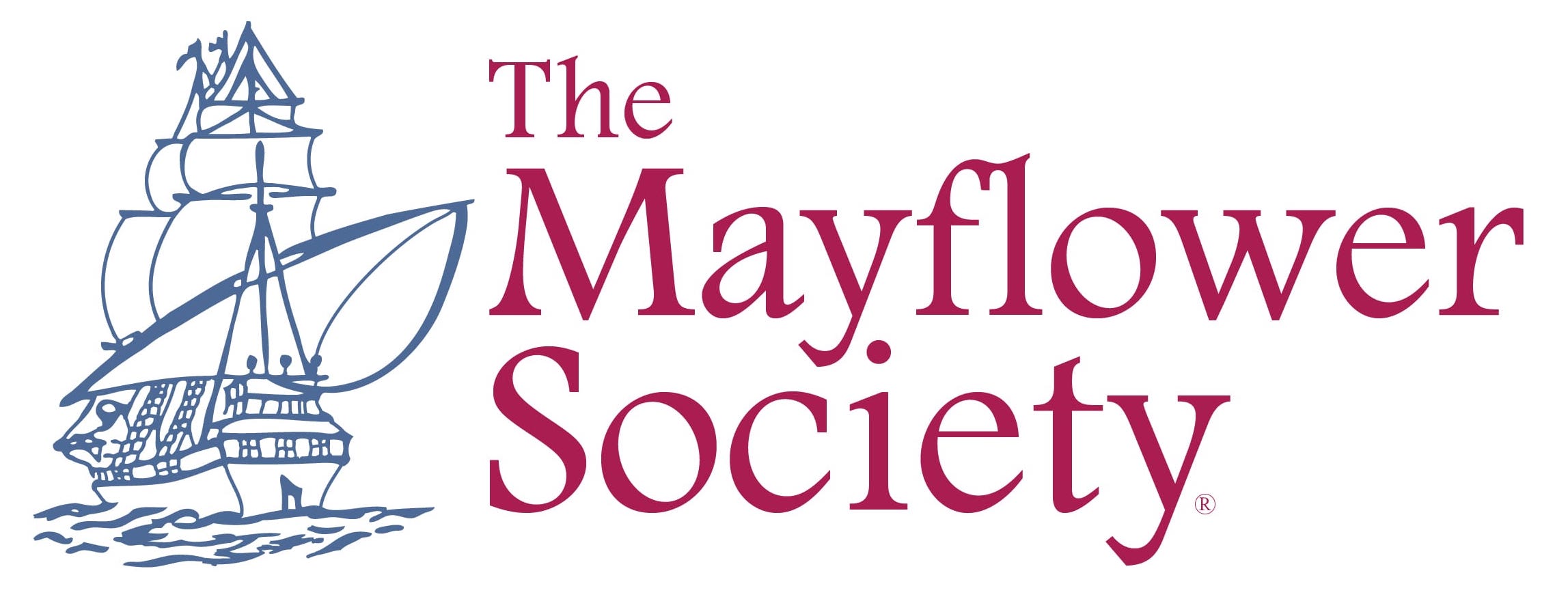

The Mayflower Voyage
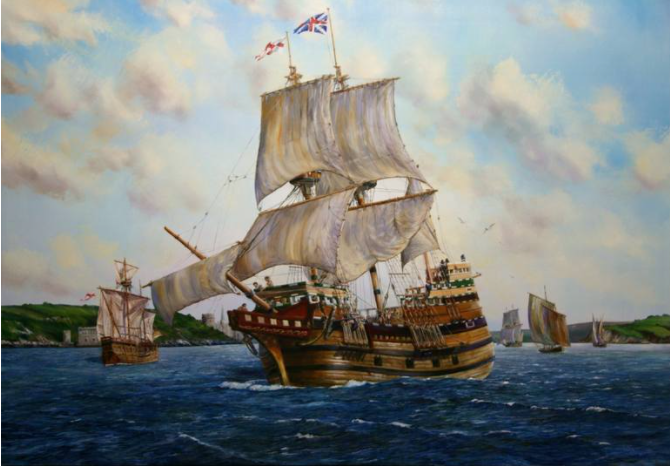
It is hard for us in this present age to imagine what it would be like not to know certain things – not know how wide the oceans were; – not to know how far Virginia was from Plymouth, England; – or from Plymouth, Massachusetts, for that matter; not to know, even, how far a ship would sail in a day or a week, and not to have any maps or charts of a good degree of accuracy for any country or any ocean on earth. All of this lack of knowledge was the situation 1620.
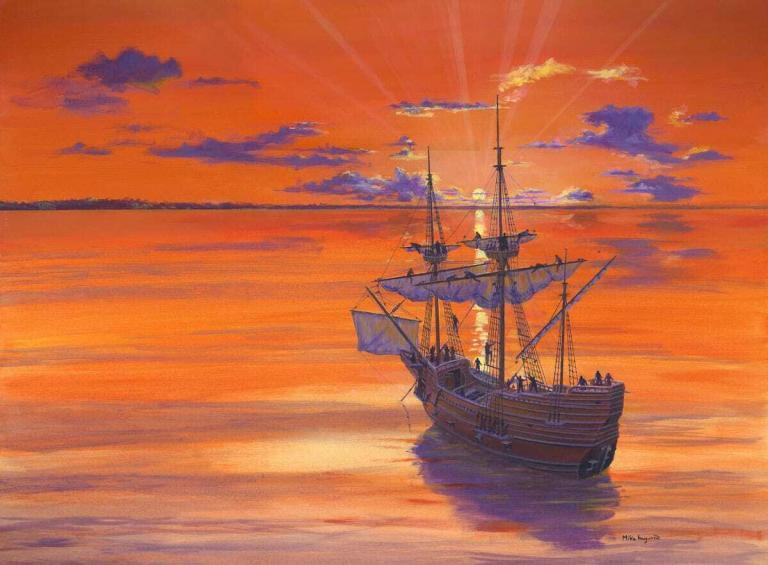
Now, of course, there was much sea-faring in 1620. Ships plied the English Channel, sailed up and down the coast of France and Spain and swarmed all over the Mediterranean. But this was mainly coastal, short voyage work. In any trip the length of time out sight of land was minimal. This is not to say that there were not trans-ocean voyages in the period. The gold trade between Spain and Mexico had flourished for years. The cost in lives and ships and cargo had been and continued to be terrific. The many recent treasure finds from sunken Spanish galleons in waters near Florida bear vivid witness to the awful costs of these many passages. These costs in men, ships and cargo were due in great degree to the ignorance of the crews and skippers and navigators. In those days the practitioners of the sea-faring art had no ability to determine accurately, on a day to day basis, their ship’s position or what dangers lurked.
So much for the state of the art in 1620. What do we find as to how many of these meager skills were possessed by Captain Jones and his crew aboard the Mayflower?
We know that Captain Jones was a part owner of the ship and had been Captain for several years. He had just returned from Spain, hauling a cargo of wine. He had traded at least once across the North Sea to Norway from Newcastle. He was probably as well suited to, and trained for, an Atlantic crossing as the average sea captain of the day. To understand just what is involved in making a crossing, whether back then or today, it is necessary to get a bit technical and describe some of the essentials of navigation and passage making in any age.
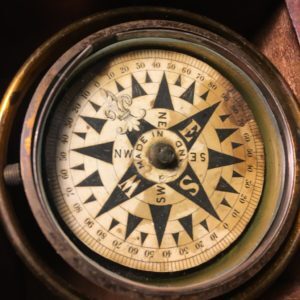
When out of sight of land, the navigator depends on several aids to keep his ship on course and to position her daily on the surface of the ocean. Then, as now, the first aid is the compass. With it he can shape his course steadily toward his destination. All of us know something about a compass, and how its north-seeking needle points to magnetic north. The discovery and use of the magnetic properties of ferrous compounds goes way, way back in time. One of the first references to a mariner’s compass is found in the writings of one Alexander Neckam, born in A.D. 1157. We are sure its use antedated this date by years and perhaps centuries.
The next aid is the traverse board . This is a kind of abacus and memo pad. A circle at the top of the board is divided by radii into the thirty-two points of the compass. Each of these radii has eight holes, evenly spaced out from the center, into which pegs can be fitted. The bottom of the board is divided by eight horizontal lines and these lines also have holes evenly spaced across their length for pegs. Then, as now, a steering watch was four hours long, divided into eight 30 minute glasses of time. At the turning of each glass (every thirty minutes), the quartermaster put a peg in the proper radius hole to represent the average course steered during the period and the proper glass number of the watch period.
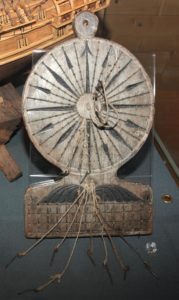
This sounds quite impressive, but the results were far from anything but rough guesses. They were at least better than no guess at all. So, with compass, traverse board and log-ship, the 1620 navigator kept his accompt book of daily positions – his dead reckoning positions. Even today, with much better compass, perfect timing devices, and excellent speedometers, the position of a ship at sea by dead reckoning may be off by a substantial mileage each day.
This leads us to the next aid the navigator must have. He must have a way of figuring his position from day to day by means independent of course or speed. The aid he uses to do this is an altitude measuring device with which he can determine the altitude of some heavenly body and, with suitable calculations, find from this measurement his location at sea. In 1620 the aids used were either an astrolabe or a Davis backstaff .
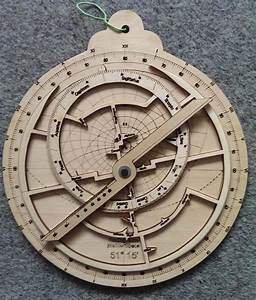
This is where Celestial Navigation comes into the picture. Celestial Navigation, in all its mathematical and astronomical theory, is rather complicated but its basic principal is simplicity itself. Poets have referred to the heavenly bodies – the sun, moon, stars and planets – as the “Lighthouses of the Sky” This poetic fancy happens to be strict, practical fact. Consider for a moment. We are on the revolving earth. It revolves from west to east, and this motion makes it appear to us that the sun and all other bodies rise in the East and set in the West. Imagine, if you will, a string running from the center of the earth to the center of a heavenly body. This string would cut the surface of the earth at a certain point at a certain time. This point is called the “GP” of the body. “GP” stands for “geographical position.” It keeps changing from moment to moment as the earth turns. Today the GP’s of fifty-seven navigational stars, four planets, the moon and the sun are listed in a Government publication issued annually and called the Nautical Almanac. This book lists these positions in terms of degrees North or South of the equator, and degrees West of an arbitrary line running through Greenwich, England. They are listed for every second of time of the year.
In 1620 no such handy volume existed. Tables of the “Declination of the Sun” for every day of the year were available, however. Declination is merely the astronomer’s name for latitude and refers to the latitude on the earth’s surface of the GP of the body. Now, remember a heavenly body moves westward in the sky rapidly, about 15 degrees an hour, but it moves slowly north or south. So a daily table of the sun’s declination is useful.
Let’s review a bit now. The aids available to Captain Jones in 1620 were the compass , the traverse board , the log ship and, of course, the second glass and hourglass. With these he did the best he could to keep his accompt book , or Log of daily dead reckoning position – his “DR.” He used his Davis backstaff or astrolabe to measure the altitude of the sun. Today he would use a sextant. This beautifully accurate instrument in the hands of a skilled observer is capable of measuring altitude angles to one six-hundredth of a degree. Captain Jones with his instrument would do well to get within a degree – some six hundred times less accurate – on board the heaving and pitching Mayflower !
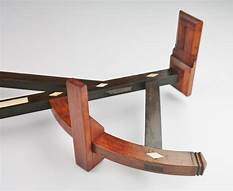
To do his best to keep from building up high cumulative errors in his dead reckoning accompt , Captain Jones practiced celestial navigation each day at high noon. High noon merely means that the sun is due north or due south of you, and is going from “rising” to “setting.” At this moment we say it is on your meridian – not A.M. or P.M. Captain Jones’s celestial navigation consisted of measuring the sun’s altitude at his best estimate of its highest point for the day.
This high point occurs at high noon (by a sun dial or compass). To make this measurement, the backstaff was probably used because it was a bit simpler on shipboard than an astrolabe. From the altitude of the sun, so obtained, and the declination for the day from the tables, Captain Jones could get his latitude by a simple calculation. We might mention here that Captain Allan Villiers carried a replica of a Davis backstaff on the voyage of Mayflower II and reported it quite useless for any meaningful accuracy. Even allowing Jones much greater accuracy than Villiers, due to more practice, it is doubtful if the latitudes obtained were much better than the DR figures which themselves were pretty awful by present day standards.
Now note that this bit of celestial observation only checked latitude. No attempt to obtain positions East or West of your departure was possible by celestial observations at that time. It would be more than a hundred years later before longitude could be found at sea.
We have mentioned the sun only as a method to obtain latitude. For centuries navigators had known that the altitude of the Pole Star, Polaris, roughly equaled the latitude of the observer. At the time of the Mayflower voyage, it is likely that Captain Jones felt he could get better results from observations of the sun. Of course, he might have observed either from time to time.
There is a whole set of circumstances in seventeenth century sailing which must not be overlooked. We must remember the life aboard a ship at those times– the almost unbelievable discomfort, the monotony, week after week after week, the cold, the wet, the poor food coupled with hard physical labor. This terrible environment made it practically impossible to exercise the careful judgment and carry out the accurate calculations which, then as now, are absolutely essential in the practice of navigation. There is no wonder that whole fleets of ships were sunk and wrecked on unfamiliar shores, and that a seaman’s life was hard and short in those far off times.
The Mayflower made history by carrying the Pilgrims to the New World. But never forget – SHE WAS ONE OF THE LUCKY ONES!
– November 1980 – VoL 46 No. 4
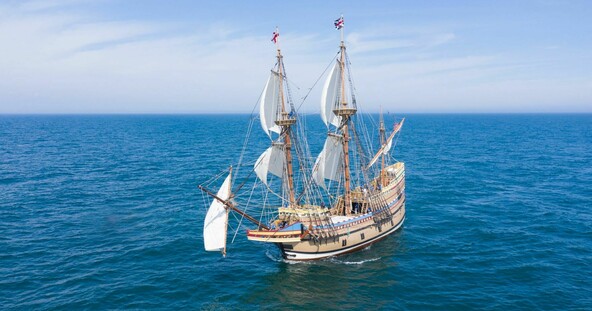
- Plan Your Visit
- Explore Our Sites
Mayflower II
All Aboard Mayflower II ! Along with national treasures such as the Statue of Liberty and the Lincoln Memorial, Mayflower is an iconic symbol of freedom. Of the hundreds of ships that made the transatlantic crossing in the 1600s, she is the ship we remember. Three hundred years later, on June 13, 1957, a full-scale reproduction arrived in Plymouth Harbor, Mayflower II .
Since then, Mayflower II has become the majestic centerpiece of historic Plymouth Harbor, and the Commonwealth of Massachusetts. In many ways, America is the product of the events that happened in Plymouth and Native Patuxet over four centuries ago—the choices made, risks taken, and the adaptation of community structures to new civic realities. Mayflower II tangibly embodies those choices and risks for hundreds of thousands of lifelong learners each year. More than twenty-five million people have stepped aboard her decks to imagine the perils and contemplate the modern impacts of the historic crossing.
Today, Mayflower II is a floating classroom and working vessel. Following her restoration and return to Plymouth in 2020, she was added to the National Register of Historic Places, illuminating that she is a historic ship in her own right.
"Like most people, I was immediately struck by how small the ship seemed - particularly in the 'tween decks, where the passengers were confined. How could 102 people, including three pregnant mothers, have survived more than ten weeks in a space this size?"—Nathaniel Philbrick, "At Sea with the Pilgrims: Writing About the Voyage of the Mayflower, " Plimoth Life, 2007.
Frequently Asked Questions
Mayflower is a square-rigged vessel that is about 25 feet wide and 106 feet long, displacing 236 tons of water. She has four masts, including a mainmast, foremast, mizzen, and sprit, with a total of six sails. You may walk around the main deck, orlop deck, and half deck.
Mayflower is not fully accessible. People with difficulty walking should be aware that there are ramps that can be steep according to the rise and fall of the tides. On the ship, there are also several flights of stairs to climb. However, those unable to board the ship may enjoy a close-up view of Mayflower from the dock, visit the dockside exhibit area, talk to modern crewmembers, and look at photographs of the interior of the ship.
Yes, we encourage you to take photographs or use video cameras for your own use. You need not ask permission of the staff to take pictures of Mayflower . Commercial use of photographs or video is prohibited without permission from our Public Relations office.
No one knows for sure what happened to the original Mayflower . The last record of the ship was an assessment of her value in 1624. After that, she disappeared from maritime records. Several places in England claim to have a piece of the original ship, but there is no historical proof to support these claims.
Mayflower passengers lived on board anywhere from seven to nine months depending on when they joined the voyage and how soon they left the ship for shelter on land.
One of the most notable differences is the large modern staircase between the main deck and the lower decks. (In the 17th century, ladders were used). Electric lights illuminating the dark corners of the lower deck were also not standard in the 1600s! There were other minor modifications made to Mayflower to make sure that she would be more accessible, safe, and comfortable for the visiting public.
Mayflower II : Her Story
Under construction.
A reproduction ship was always part of Harry Hornblower’s vision for Plimoth Patuxet Museums (learn more about his vision here). In 1951 Plimoth Patuxet (then known as Plimoth Plantation) contracted naval architect, William A. Baker, to research and design plans for a ship the size and type of the original Mayflower. At nearly the same time, unbeknownst to Plimoth Patuxet, a similar project was developing in England. Warwick Charlton founded Project Mayflower Ltd. to honor the alliance of friendship forged between the United States and United Kingdom during World War II. Charlton’s team came across an article written by Baker, and after connecting with Plimoth Patuxet, a new partnership was born. Plimoth Patuxet provided Baker’s research and plans to Project Mayflower Ltd. Of course, that is just the start of Mayflower II’ s journey!
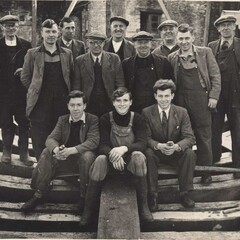
[ Above Photo Captions: Photo 1: Generations of shipwrights on Mayflower II’s frame at the J.W. & A. Upham Shipyard; Photo 2: A shipwright works in the hull of Mayflower II . Note the “Mayflower” banner flown between a United States and United Kingdom flag; Photo 3. Shipwrights, community members, dignitaries, and project leaders gather for the keel laying ceremony in July 1955. Note the United Kingdom and American flags tied together above the bean in tribute to the friendship between the two countries the ship exemplified following World War II; Photo 4: A shipwright works on Mayflower II using traditional 17th-century methods and tools. Photo 5: View of Mayflower II’s Main deck and Beak; Photo 6: Mayflower II , nearing completion and being rigged by shipwrights in Brixham. ]
Her Maiden Voyage
Mayflower II set sail from Plymouth, England on April 20, 1957 with a crew of thirty-three men under the command of acclaimed Captain Alan Villiers. As they neared Massachusetts shores, Mayflower II ran into a violent squall. No one aboard had experience with handling a 17th-century vessel in inclement weather. However, Captain Villiers remembered that William Bradford, famed Governor of Plymouth Colony and passenger aboard the original Mayflower during her 1620 voyage, wrote in his manuscript, Of Plimoth Plantation , how Master Christopher Jones steered the original ship to safety during the 1620 voyage by lying ahull. Quickly recalling this note, Villiers and the crew executed the same maneuvers and calmly rode out the storm. On June 13, 1957 Mayflower II arrived in Plymouth, Massachusetts to a crowd of 25,000 adoring spectators.
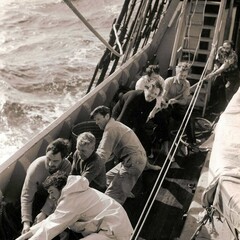
[Above Photo Captions: Photo 1: Stuart Upham, second from rear, hauls a line with fellow Mayflower II crew members in 1957; Photo 2: Mayflower II undersail in the Atlantic Ocean; Photo 3: A selection of images of the crew aboard Mayflower II during her 1957 maiden voyage. Top right, a batch of rolls fresh out of the oven in Mayflower II ’s galley. Top left, crew members demonstrate 17th-century medical procedures with leeches while under sail. Bottom right, Captain Villiers delivers a Sunday service to the crew. Bottom left, a crew member sketches and paints; Photo 4: A selection of images from the 1957 voyage. Top right, crew members dressed in Pilgrim attire on the Main deck. Top left, Captain Villiers, in Pilgrim attire, addresses his crew on the Main deck. Bottom right, a crew member at the ship’s wheel during the day. Bottom left, a crew member at the ship’s wheel at night; Photo 5: The 1957 Mayflower II crew with Captain Villiers; Photo 6: Mayflower II arrives in Plymouth on June 13, 1957 and is greeted by thousands of spectators along the waterfront. ]
Her Triumphant Restoration
“ Mayflower II is a source of inspiration to those in search of new beginnings and the possibility of multicultural cooperation in this nation of immigrants. Upon her return to Plymouth Harbor she once again became a kind of time machine…to a past that only gains in resonance and importance with each passing day.”—Nathaniel Philbrick
After 3+ years of restoration and 3 weeks of sea trials, on August 10, 2020 Mayflower II departed a slip at Mass Maritime Academy headed for home. With great fanfare and a flotilla along the way, the ship nestled back into her berth in Plymouth Harbor later that day.
Following her return, on October 22, 2020 Mayflower II was named to the National Register of Historic Places. She was deemed historically significant for her association with the founding story of the United States and as a full-scale ship that embodies the distinctive characteristics of a 17th-century English merchant vessel. In April 2021, Mayflower II received a Paul & Niki Tsongas Award from Preservation Massachusetts in recognition of the project’s significant work in historic ship restoration, and went on to win Preservation Massachusetts’s People Choice Award the following month.
[All photos in the below gallery are from Mayflower II ’s August 2020 homecoming following her restoration.]
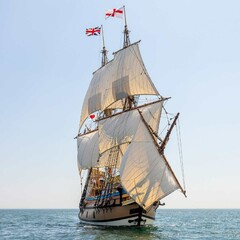
Mayflower II Museum Shop Merch
Shop exclusive Mayflower II merchandise from the Plimoth Patuxet Museum Shops! From jewelry made from wood salvaged during the ship’s restoration to apparel, children’s books, and art, the decks are stocked with a bounty of exclusive goods. Shopping Mayflower II ’s merchandise is a wonderful way to fill her sails and support her educational mission!
Shop exclusive Mayflower II merchandise
- History Classics
- Your Profile
- Find History on Facebook (Opens in a new window)
- Find History on Twitter (Opens in a new window)
- Find History on YouTube (Opens in a new window)
- Find History on Instagram (Opens in a new window)
- Find History on TikTok (Opens in a new window)
- This Day In History
- History Podcasts
- History Vault
The Pilgrims’ Miserable Journey Aboard the Mayflower
By: Dave Roos
Updated: September 6, 2023 | Original: November 18, 2020

Sailing for more than two months across 3,000 miles of open ocean, the 102 passengers of the Mayflower—including three pregnant women and more than a dozen children—were squeezed below decks in crowded, cold and damp conditions, suffering crippling bouts of seasickness, and surviving on meager rations of hardtack biscuits, dried meat and beer.
“The boat would have been rolling like a pig,” says Conrad Humphreys , a professional sailor and skipper for a recreated sea journey of Captain William Bligh. “The smell and stench of illness and sickness down below, and the freezing cold on deck in the elements, it would have been pretty miserable.”
The Mayflower , like other 17th-century merchant ships, was a cargo vessel designed to haul lumber, fish and casks of French wine—not passengers. The 41 Pilgrims and 61 “strangers” (non-Separatists brought along as skilled craftsmen and indentured servants) who boarded the Mayflower in 1620 made for unusual cargo, and their destination was no less foreign. The ship’s square rigging and high, castle-like compartments were suited for short hops along the European coastline, but the Mayflower’s bulky design was a handicap for sailing against the strong Westerly winds of the North Atlantic.
“The journey would have been painfully slow with many days of being blown backward rather than forward,” says Humphreys.
Incredibly, though, all but one of the Mayflower’s passengers survived the grueling, 66-day ordeal, and the Pilgrims even welcomed the arrival of a newborn baby halfway through the journey, a boy aptly named Oceanus. The Pilgrims’ joy and relief on catching sight of Cape Cod on the morning of November 9, 1620 was recorded by their leader William Bradford in Of Plymouth Plantation .
“Being thus arrived in a good harbor and brought safe to land, they fell upon their knees and blessed the God of heaven, who had brought them over the vast and furious ocean, and delivered them from all the perils and miseries thereof," wrote Bradford.
From Two Ships to One

The Pilgrim’s arduous journey to the New World technically began on July 22, 1620, when a large group of colonists boarded a ship called the Speedwell in the Dutch port city of Delfshaven. From there, they sailed to Southampton, UK, where they met the rest of the passengers as well as a second ship, the Mayflower. The two ships disembarked from Southampton on August 6 with hopes of speedy crossing to northern Virginia.
But just hours into the journey, the Speedwell began to leak badly, and the two ships were forced to pull in at Dartmouth. The Speedwell was finally ready to sail again on August 24, but this time only made it 300 miles before springing another leak. The frustrated and exhausted Pilgrims docked at Plymouth and made the difficult decision to ditch the Speedwell. Some of the Pilgrims also called it quits in Plymouth, but the rest of the passengers and cargo from the Speedwell were transferred to the already overcrowded Mayflower.
The traditional account of the Mayflower journey begins on September 6, 1620, the day it sailed from Plymouth, but it’s worth noting that by that point the Pilgrims had already been living aboard ships for nearly a month and a half.
Life on the Gun Deck

The Mayflower was about 100 feet long from stem to stern and just 24 feet wide. In addition to its 102 passengers, the Mayflower carried a crew of 37 men—sailors, cooks, carpenters, surgeons and officers. The crew was housed in small cabins above the main deck, while the Pilgrims were consigned to the “gun deck” or “between decks,” a suffocating, windowless space between the main deck and the cargo hold below.
“These lower decks were very cramped, cold and wet, with low ceilings no more than five feet tall,” says Humphreys. “And all around you, people are getting seasick. It’s really not a very nice place to be.”
The passengers shared the gun deck with a 30-foot sailboat called a “shallop” that was stored below decks until their arrival in the New World. Between the masts, storage rooms and the shallop, the total available living space for 102 people measured only 58 feet by 24 feet. The passengers practically slept on top of each other, with families erecting small wooden dividers and hanging curtains for a semblance of privacy.
“The crew would occasionally let some of the passengers up on deck to get some fresh air, but on the whole, the Pilgrims were treated like cargo,” says Humphreys. “The crew were worried about people being swept overboard. The journey was difficult enough for seasoned sailors, nevermind novices like the Pilgrims.”
Biscuits and Beer
Mealtime on the Mayflower brought little to celebrate. The cooks would have run out of fresh food just days into the journey and instead relied on salted pork, dried fish and other preserved meats. Since regular bread would spoil too quickly, they served hardtack biscuits, jaw-breaking bricks made from flour, water and salt.
“The beverage of choice for many of these old voyages was beer,” says Humphreys, explaining that casks of fresh water tended to go “off” during long storage. “Even young children were given beer to drink.”
Subsisting on small rations of salted meats and beer, the Pilgrims would have been malnourished, dehydrated, weak and susceptible to scurvy. When Humphreys recreated Bligh’s 60-day crossing of the South Pacific, he and his crew ate only 18th-century rations—about 400 calories per person per day—and each man lost 25 percent of their body weight.
Stormy Weather and the 'Great Iron Screw'
Bradford’s short description in Of Plymouth Plantation of life aboard the Mayflower is the only surviving account of the crossing, but it includes enough harrowing details to understand how close the journey came to disaster.
After a month of relatively calm seas and smooth sailing, the Mayflower encountered the first of an unrelenting series of North Atlantic storms that buffeted and battered the ship for weeks. The crew was forced on several occasions to lower the sails and let the Mayflower bob helplessly in the towering waves.
“They were encountered many times with cross winds and met with many fierce storms with which the ship was shroudly shaken, and her upper works made very leaky,” wrote Bradford, “and one of the beams in the midships was bowed and cracked, which put them in some fear that the ship could not be able to perform the voyage.”
Whether Bradford was talking about a cracked mast or another type of wooden beam is unclear, but the damage was serious enough for the Pilgrims to call a meeting with the captain to discuss turning back. But then something remarkable happened.
“…There was a great iron screw the passengers brought out of Holland, which would raise the beam into his place,” wrote Bradford, describing an object that was either the screw of a printing press or a large jack to raise the roof of a house. Either way, it worked, and the Pilgrims “committed themselves to the will of God and resolved to proceed.”
An Unexpected Swim
During one of those brutal storms, when the Mayflower was forced to draw its sails and “hull for divers days,” one of the passengers apparently became desperate for a breath of fresh air. Bradford wrote that a “lusty young man” named John Howland wandered onto the main deck and “with a seele [or pitch] of the ship [was] thrown into the sea.”
By some miracle, Howland was able to grab hold of the halyards hanging overboard and hold on for dear life, “though he was sundry fathoms under water,” wrote Bradford. Working quickly, the crew pulled Howland close enough to the ship to snag him with a hook and haul the foolhardy young man back onto the deck. Bradford proudly reported that after a short sickness, Howland not only recovered, but “lived many years after, and became a profitable member both in church and commonwealth.”
The Death of William Butten, the First of Many

Bradford makes only passing mention of the one death on the Mayflower. A young boy named William Butten, an indentured servant to one of the Pilgrims, fell ill during the journey and died just a few days shy of reaching the New World.
Given the dangers of the journey and the rough conditions aboard the Mayflower, it was a miracle that only one person out of 102 perished on the 66-day voyage. Sadly, the Pilgrims’ fortunes changed for the worse once they landed at Cape Cod in early November. The passengers and crew continued to live on the Mayflower for months as permanent dwellings were constructed on the shore.
With each passing week, more and more Pilgrims and their “stranger” companions succumbed to bitter cold and disease. By spring 1621, roughly half of the Mayflower’s original passengers had died in their new home. Among them was little Oceanus. In one piece of good news, another baby named Peregrine, the first Pilgrim baby born in the Plymouth Colony , not only survived the brutal winter, but lived on for more than 80 years.

HISTORY Vault: Lost Colony Of Roanoke
In 1590, the settlers of Roanoke—the first English colony in the New World—were discovered to be missing. The only clues: five buried chests and the word "Croatoan," a Native American village nearby, carved on a post. Archaeologists search for answers.

Sign up for Inside History
Get HISTORY’s most fascinating stories delivered to your inbox three times a week.
By submitting your information, you agree to receive emails from HISTORY and A+E Networks. You can opt out at any time. You must be 16 years or older and a resident of the United States.
More details : Privacy Notice | Terms of Use | Contact Us

Mayflower400 partner destinations:
The Mayflower Voyage
For the passengers and crew who boarded the Mayflower some four centuries ago, the odds were firmly stacked against them as they looked to cross the Atlantic to start a new life .
By the time the group set sail from Plymouth on 16 September 1620, many of them had experienced religious persecution; trouble with the law (including time in prison for some); betrayal from those they trusted; numerous stops in ports around the country, and the eventual demise of the Mayflower’s sister ship, the Speedwell.
Little did they know, their hardships would only get worse during a voyage which saw emergency repairs, disease, death and even the birth of a new child.
Below you can read stories about the Mayflower’s historic journey, and how the colonists finally reached North America after 66 gruelling days at sea.
The Mayflower Story
The Mayflower set sail on 16 September 1620 from Plymouth, UK, to start its long voyage to America.
But its history and story start long before that in the villages, towns and cities of England.
Mayflower – The journey to 16 September
The Mayflower eventually set sail from Plymouth, UK, on 16 September 1620 to start what would prove to be a treacherous transatlantic voyage to America.
This is the fascinating story of how the colonists made the trip possible, and the events that led to them gathering on the water’s edge in Devon some 400 years ago.
How the Mayflower prepared for its historic transatlantic voyage
As with any long trip, preparation is key - and the colonists had spent many months leading up to their departure gathering provisions and supplies that would last them during their voyage and beyond.
One can only image how cramped and crowded conditions would have been on the Mayflower with more than 100 passengers on board and provisions to match.
66 days at sea: What life was like on board the Mayflower
The odds were firmly stacked against the passengers and crew who boarded the Mayflower some four centuries ago in a bid to start a new life across the Atlantic.
Little did the group know, their hardships would only get worse during a voyage which saw emergency repairs, disease, death and even the birth of a new child.
The Mayflower Compact
With America almost close enough to touch, the battered and broken Mayflower passengers knew their journey was far from over, for they had no right to settle on the land upon which they had unintentionally arrived.
The Pilgrims anchored in what is now Provincetown Harbour, Massachusetts, and decided to draw up an agreement that would give them some attempt at legal standing.

Millions owe their lives to Mayflower passenger who fell overboard
As if the colonists' perilous transatlantic crossing wasn't harrowing enough, imagine how frightened John Howland must have been when he fell overboard as a storm of epic proportions battered the Mayflower?
Howland was thrown overboard during nightmare sea conditions but managed to grab hold of a trailing rope, giving the Mayflower crew just enough time to rescue him with a boat-hook.
The Boy Who Fell From The Mayflower
The Boy Who Fell From The Mayflower (Or John Howland’s Good Fortune) is a beautifully illustrated children’s book that tells the imagined story of a real-life passenger aboard the pioneering ship.
John Howland was a teenager in 1620 when he sailed to America as an indentured servant. His story and the Mayflower’s dramatic voyage from Plymouth is vividly brought to life by writer and illustrator P.J. Lynch.
What happened after the Mayflower landed in America?
After more than two months battling everything the Atlantic had to throw at them, the Mayflower passengers' horrific ordeal was far from over.
What lay ahead were many more months of trials and tribulations which would test their spirit and, ultimately, decimate their numbers as they lost family, friends and loved ones to disease and the elements.
The unbreakable bond of the original Mayflower passengers who survived their first winter in America
Shared pain is undoubtedly one of the most powerful factors in bringing people together.
So, it’s no surprise that those who reached America in November 1620 and survived the subsequent first harsh winter had shared an experience that no other European could possibly understand.
How the Mayflower passengers started to build a colony
The Mayflower passengers and crew reached the coast of America during a harsh winter which brought with it heavy snow.
Conditions made it incredibly difficult, but the group put together three exploring parties over the course of the month between the middle of November and the middle of December.
Who were the children of the Mayflower?
Little is known about the children who sailed on the Mayflower some 400 years ago, but it is thought that there were around 30 on board the ship when the group departed Plymouth.
Richard Pickering, Deputy Director of Plimoth Patuxet Living Museum, explores more about the children of the Mayflower.
Sign up for the latest Mayflower 400 news
You'll be the first to hear the latest Mayflower news, events, and more.
Forgotten Password?
Mayflower 400 Proudly Supported by our National Sponsors and Funding Partners

- Website Privacy Policy
- Video Series
- Exploration
- Historiography
Discerning History
About Store Return Policy Wholesale Orders Contact Us

Priscilla Alden: Maiden of the Mayflower
If a visitor today to Plymouth, Massachusetts has the patience to seek out a quiet corner of Brewster Gardens, near the banks of the old Town Brook, he will be rewarded to see among the trees and flowers a monument dedicated to the “Maidens” of the Mayflower. The monument consists of a copper statue of a girl looking bravely forward into the future, a Bible in her hand and hope in her eyes.
We know very little about the handful of young girls that left their secure homes in England and the Netherlands to cross an unknown ocean establish a new home in the wilderness. Because only four adult women survived the first winter, much of the labor and toil of Plymouth Colony fell upon the inexperienced shoulders of the younger girls.
One “Maiden of the Mayflower” was a seventeen-year-old girl named Priscilla Mullins. Her father was William Mullins, an English shoemaker and businessman from Dorking in Surrey. The Mullins family were not members of the Leyden Congregation, and they were thus among the “Strangers” aboard the Mayflower. They did not board the ship in the Low Countries but were part of the contingent from London who joined the expedition on the coast of England.
Seventeen would be a very difficult age for a girl to leave her home and venture with her parents into a howling wilderness. Priscilla was at the age when most girls of her generation were considering marriage, and it would have been very obvious that the pickings would be few in the New World. It would have been much easier to remain in England where the number of prospective husbands was much greater, and where she was already comfortable.
Priscilla had already lost her mother as a little girl. William Mullins had remarried a lady named Alice, who joined him in the venture to the New World. While William left his two eldest children behind in England, he took Priscilla and her fifteen-year-old brother, Joseph, along with him. Thus, the Mullins family consisted of Priscilla’s father, William, her step-mother, Alice, Priscilla herself, and her younger brother, Joseph. Also traveling with the family was an apprentice named Robert Carter. Shoes are an important commodity in any wilderness colony, and William Mullins carried a good stock of sturdy shoes and boots with him which later proved to be very useful in the New World.
The entire Mullins family survived the stormy voyage across the Atlantic Ocean, and the name of Mr. William Mullins appears as a signer of the Mayflower Compact. During the first difficult winter at Plymouth Colony, the Mullins family at first escaped unscathed. Many of the other families lost at least one, but the Mullins did well until the father, William Mullins, became very sick during the last few days of February, 1621. His condition worsened, and he wrote a hasty will that was committed to the care of Governor John Carver. After a short sickness, Mr. William Mullins died on February 21, leaving a widow and two orphaned children.
It is never easy for a girl to lose her father, but for a Priscilla to lose her father at such a time, when she was just blossoming into womanhood, would have been very difficult indeed. But tragedy followed tragedy, and the worst was not yet over for Priscilla. The family apprentice, Robert Carter, followed his master to the grave. Even as the weeks of spring crept on and the casualties began to diminish, Priscilla lost her stepmother, Alice. Sometime during that summer, she stood with tearful eyes over the grave of her brother, Joseph, leaving her the lone survivor of her family.
Many girls in her situation would have given up all hope of life in such a harsh frontier, and would have sought the first opportunity to return to comfortable England and sought refuge with her older brother and sister. Courageously, Priscilla Mullins decided to stay in Plymouth, where her father lay buried on Cole’s Hill. As the lone survivor of her family, she resolved that she would not give up.
One incident in the life of Priscilla Mullins has been made famous by the poem of Henry Wadsworth Longfellow, “The Courtship of Myles Standish.” In the poem, Captain Myles Standish, having lost his first wife in that same General Sickness, is said to have fallen in love with young Priscilla. Too bashful to make his romantic interest known, he sent his friend and roommate, a young cooper named John Alden to make the request for him. When John Alden finally spoke to Priscilla Mullins, she is supposed to have given the reply, “Why don’t you speak for yourself, John?” suggesting that John Alden was also in love with one of the very few girls of marriageable age in the colony.
Although this romantic story is often dismissed as a mere fable of a poet, there are some things that give credence to the story. Longfellow was himself a descendant of Priscilla, and a collaborating written record has surfaced that suggests that Longfellow may have been passing along an oft repeated family story that was indeed based in fact.
Whether Myles Standish sought the hand of Priscilla or not, she did opt to marry the young but poor cooper named John Alden. John Alden was also a “Stranger,” a young man brought along for his skill as a cooper rather than for his adherence to the Separatist church.
John Alden and Priscilla Mullins were married in what is presumed to be the fourth marriage in Plymouth Colony. They eventually settled in Duxbury, to the north of Plymouth, where their homestead has recently been discovered. Interestingly, John Alden and Myles Standish remained close friends throughout their lives, and raised their families together. They rest together in the same cemetery in Duxbury, awaiting the resurrection. In a beautiful close to the supposed romance, the son of Myles Standish married one of the daughters of John and Priscilla.
The character of young Priscilla Mullins lived on in her descendants. This brave young “Maiden of the Mayflower” who would not give up and go home went on to become the mother of a multitude, many of whom held important posts in church and state. She and John Alden had ten children, dozens of grandchildren, and hundreds of great-grandchildren.
John Adams and John Quincy Adams were both direct descendants of Priscilla Mullins, the girl who would not quit. In spite of losing her mother, her father, her step-mother, and her brother, she cast her lot here on the rugged shores of the New World and place her hope and trust in the promises of a faithful God. Priscilla’s faith, her determination, and her courage give us an inspiring legacy, and we must pray that a new generation of young girls will rise up and follow her noble example.
Reformation Day Livestream 2021
The voyage of the mayflower, you might also enjoy.
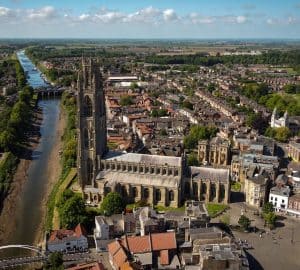
On Bradford’s Trail: Boston
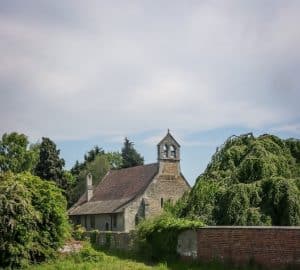
On Bradford’s Trail: Austerfield Chapel

Karolina Sandell-Berg: Strength I Find to Meet My Trials Here
Leave a response cancel reply.
Save my name, email, and website in this browser for the next time I comment.
Robert Jermaine Thomas: Korea is Opened to the Gospel
On bradford’s trail: scrooby manor, stay connected.
The maiden voyage of the Mayflower II: Provincetown was first again
My knowledge of the world drops off sharply beyond the Orleans rotary, but the recent hullabaloo about the Mayflower II passing through the Cape Cod Canal really sizzled my synapses.
Thus, a steep learning curve began. I figured the "II" in the name of the ship was likely a clue that the original Mayflower had retired to The Villages in Florida and was raising heck on a tricked-out golf cart.
But that doesn't seem to be the case, although the fate of the original Mayflower appears to be murky, at least to a bumbling historical sleuth like me.
An intriguing possibility about what happened to the Mayflower was raised by noted historian and physician Charles Edward Banks in his 1929 book about the English ancestry and homes of the Pilgrims. Here's what he wrote:
"What finally became of her is an unsettled problem. Dr. Rendel Harris, an English historian of the Pilgrim ship, has published interesting material which he claims as proof that this historic vessel was finally broken up and her timbers used in the construction of a barn at Jordan's (village) in Buckinghamshire."
So let's assume the original Mayflower is no more. How the heck did folks come up with the idea to build a replica in the first place?
According to an account on the Plimoth Patuxet Museums website , a reproduction of the Mayflower "was always part of (founder) Harry Hornblower’s vision for Plimoth Patuxet Museums." The organization contracted a naval architect to cook up plans for a Mayflower-type ship in the early 1950s.
A similar plan was springing to life at roughly the same time in England, where a fellow named Warwick Charlton had founded Project Mayflower Ltd. "to honor the alliance of friendship forged between the United States and United Kingdom during World War II," according to Plimoth Patuxet .
Team Charlton read an article by Plimoth Patuxet's naval architect, which led to Plimoth Patuxet sharing their research and plans. The game was afoot!
According to his 2002 obituary in The Telegraph, an English newspaper, "Charlton was determined that everything about the ship and its voyage should be authentic."
The Mayflower II was built in Devon, England in the mid-1950s, as the creative Charlton was able to find all sorts of ways to finance the replica, including charging folks two shillings to get a look at the ongoing construction.
According to Charlton's obituary, "On April 20, 1957, amid much publicity on both sides of the Atlantic .... the 33-man crew, dressed as Pilgrim Fathers, set sail from Brixham. Powered solely by sail, Mayflower II took 54 days .... to cross the Atlantic, during which time the crew encountered a violent storm and a severe depletion of supplies. The beer ration was reduced to a bottle a day."
The final destination on the ship's maiden voyage was Plymouth , a seaside town located somewhere off-Cape. But all Cape Codders know that the original Pilgrims stopped in Provincetown first , and so did the Mayflower II.
The June 13, 1957 front page headline in the Provincetown Advocate newspaper read: "Mayflower II Makes Safe Harbor Here As Thousands Line Shore In Welcome."
Here's some of the Advocate story: "The Mayflower II rounded Long Point and headed into the harbor at 12:30 yesterday afternoon, 53 days out of England, thus marking Provincetown's authentic place in the history of the nation as the first landing place of the Pilgrims."
Local officials also stressed the Provincetown-first storyline: "Joseph Lema Jr., Chairman of the Board of Selectmen, reading from a scroll, said, 'You have attested your fidelity to history by stopping first in the waters of this ancient Town of Provincetown where your forefathers first touched foot on the soil of the Western hemisphere."
It seems the Pilgrim rivalry between Provincetown and Plymouth was still going strong back then. The Advocate article ends with this: "Whatever follows in Plymouth will be anti-climatic, Provincetown felt. For this original landing place the real story took place in the harbor, here."
Eric Williams, when not solving Curious Cape Cod mysteries, writes about a variety of ways to enjoy the Cape, the weather, wildlife and other subjects. Contact him at [email protected] . Follow him on X: @capecast.
Thanks to our subscribers, who help make this coverage possible. If you are not a subscriber, please consider supporting quality local journalism with a Cape Cod Times subscription. Here are our subscription plans.
MayflowerHistory.com
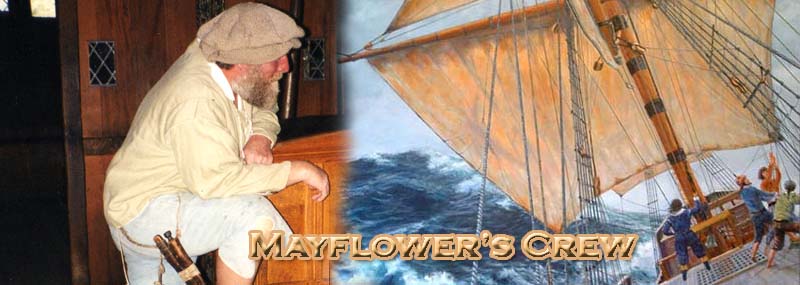
The Mayflower would have been crewed by about thirty men. Of those, only a handful can be identified with historical records.
Ship's Master, Christopher Jones The ship's master (the term "captain" was only used for military ships at this time) was Christopher Jones. He was born about 1570, the son of Christopher and Sybil Jones of Harwich, Essex, England. He lived in Harwich until about the age of 40, when he then moved to Rotherhithe, Surrey, England, a short distance from London on the river Thames. His first ship of record was called the Josian , named after his wife. He sold that ship about 1608, and purchased the Mayflower with three others. He had nine children, but most of them died in infancy. He was about fifty years old when he was hired to transport the Pilgrims to America onboard his ship.
Ship's Pilot and Master's Mate, John Clarke John Clarke had been a ship's pilot on a voyage to Jamestown, Virginia in 1611, in the fleet that brought Sir Thomas Dale to govern the colony. He lived and worked ferrying cargo in the bay for about 40 days, until a Spanish ship came into the harbor. He was taken prisoner, tied up, and sailed first to Havana, Cuba, and later to Malaga, Spain, where he would be repeatedly interrogated by Spanish authorities. After five years imprisonment, he was released to the English in 1616. He took a load of cattle to Jamestown again in 1618, and was then hired for the Mayflower 's voyage.
Master's Mate, Robert Coppin. Not much is known about Robert Coppin, other than he claimed to have been to New England on a previous voyage and claimed to have some experience whaling. He may have come from the vicinity of Harwich, and a man of that same name invested a small sum to purchase a share in the Virginia Company of London in 1609.
Cooper (Barrel-maker), John Alden. Twenty-one year old John Alden was hired in Southampton, England, where the Mayflower took on provisions, but he may also have originally been from Harwich, as there was an Alden family living there that was related, by marriage, to Master Christopher Jones. Alden's job was to build, repair and maintain the ship's barrels. This was a very important job, since everyone's food and drink were stored within those barrels. The Pilgrims' joint-stock company had agreed to allow him to decide whether he would stay in their Colony, or return to England. John Alden ultimately decided to stay.
Ship's Surgeon, Giles Heale. Giles Heale was born about 1595, and had just completed his apprenticeship in London as a Barber-Surgeon on 3 August 1619 with Edward Blanie. Just prior to the Mayflower's voyage, on 2 May 1620, Giles Heale filed his marriage intention to Mary Jarrett of St. Giles in the Fields. The voyage of the Mayflower was quite probably Giles Heale's first "real" job. Given that half the crew and half the passengers would ultimately die, he may have been quite unprepared for what ultimately played out. In February, during the height of the first winter at Plymouth, Mayflower passenger Isaac Allerton gifted him a book, Annotations Upon the Psalms by Henry Ainsworth. Giles Heale regifted the book to his wife Mary on 28 February 1621/2. The book still survives and is at the Library of Virginia in Richmond. Giles Heale also witnessed the February 1620/1 will of William Mullins. He returned to London after the voyage and took up residence at St. Anne Blackfriars, where a daughter Mary was baptized on 23 April 1623, and buried four days later. They had a son William baptized 11 March 1624/5 at St. John of Wapping, London, but he is buried 21 October 1625 in neighboring St. Mary Whitechapel. They had no more children. Heale was admitted to the lecture bills of the Barber Surgeons in 1631, and was taxed at Drury Lane in 1641 and 1646. In 1644, he and his wife were involved in a Chancery lawsuit over a debt owed them by William Chamberlain of London, esquire. He was buried 8 April 1653 at St. Giles in the Field, London, producing a will four days earlier that only mentioned his wife Mary.
Master Gunner. The master gunner was responsible for the maintenance and readiness of the ship's guns, powder, and canon. Though his name was not recorded, it is known that the Master Gunner went out on the expedition of 6 December 1620 exploring Cape Cod, where it was reported he was "sick unto death (but hope of trucking made him to go)." He died the first winter.
Ship's Carpenter. The ship's carpenter was responsible for stopping leaks, caulking, splicing masts, and fixing anything ship-related that broke or needed mending. He was responsible for maintaining his tools and supplies, including nails, cinches, hatchets, saws, and rudder iron. When the main beam of the Mayflower cracked during the middle of the voyage, the Master Carpenter made the repairs with a giant screw that the passengers happened to have with them. He also assisted in constructing the shallop that the Pilgrims had dismantled and stored betwixt the decks.
The Boatswain. The boatswain was responsible for the ship's rigging, rope, tackle, and sails, as well as the ship's anchors and the ship's longboat. William Bradford remembered that the Mayflower 's boatswain was "a proud young man, who would often curse and scoff at the passengers, but when he grew weak they had compassion on him and helped him." Despite that help, the boatswain died the first winter.
The four Quartermasters. The quartermasters were in charge of maintaining the cargo hold and setting and maintaining the shift and watch hours. The quartermasters were also responsible for fishing and maintaining the lines, hooks and harpoons. Though the names of the Mayflower 's quartermasters are unknown, it is known that three of the four of them died the first winter at Plymouth.
The Ship's Cook. The cook was responsible for preparing the meals for the crew, and maintaining the food supplies and the ship's cook room (typically located in the forecastle of the ship). The Mayflower 's cook also died the first winter at Plymouth.

Mayflower AI sea drone readies maiden transatlantic voyage
Over its roughly three-week trip from England to the United States, the Mayflower will be guided by an artificial intelligence-powered ‘captain’ and make the journey without humans on board.
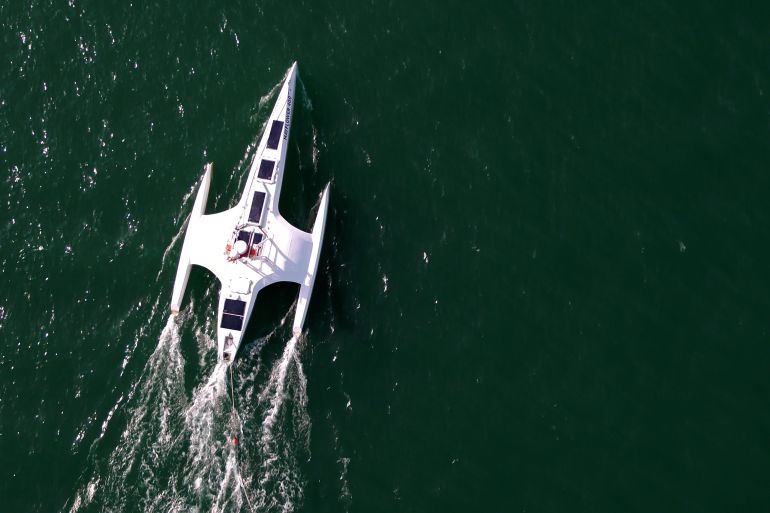
Another ship called the Mayflower is set to make its way across the Atlantic Ocean this week, but it won’t be carrying English pilgrims — or any people — at all.
When the Mayflower Autonomous Ship leaves its home port in Plymouth, England to attempt the world’s first fully autonomous transatlantic voyage, it will have a highly trained “captain” and a “navigator” versed in the rules of avoiding collisions at sea on board, both controlled by artificial intelligence (AI).
Keep reading
Bezos in space: amazon ceo, brother claim seats on first flight, money bots: the truth behind high-frequency trading, what’s behind jeff bezos and elon musk’s moon feud, new zealand turns to drones to halt māui dolphin extinction.
The ship’s AI captain was developed by Marine AI and is guided by an expert system based on IBM technologies, including automation software widely used by the financial sector. The technology could someday help crewed vessels navigate difficult situations and facilitate low-cost exploration of the oceans that cover 70 percent of the Earth’s surface.
Over its roughly three-week trip, the Mayflower sea drone will sail through the Isles of Scilly and over the site of the lost Titanic to land in Plymouth, Massachusetts, as the colonists on the first Mayflower did more than 400 years ago.
This sleek new vessel, however, will carry experiments instead of people, and has more room for experiments because it has been designed without sleeping quarters, a galley or a bathroom.
Up to 700kg of experiments can be housed in modular compartments inspired by the design of the payload bay of a space shuttle.
“Right now, it’s full to the brim,” Brett Phaneuf, a managing director at MSubs, which built the Mayflower for the non-profit Promare and its partner IBM, told attendees at the May Xponential conference held by the Association for Unmanned Vehicle Systems International (AUVSI).
Science on board
There are a host of additional companies, individuals and universities that have contributed experimental technology and data-gathering equipment, Phaneuf said.
As a result, the Mayflower will be able to study sea levels, measure wave height and gather water samples for testing at regular intervals throughout its voyage.

The Mayflower will also do pollution sampling and document water chemistry. On board will be a holographic microscope for scanning water samples for microplastics — bits of plastic 5mm or less that are harmful to ocean life.
To determine water chemistry, one of the experiments will literally “taste” the water with a test originally devised to uncover counterfeit wine and whisky.
“You can dip the ‘tongue’ into the liquid and it will give you the exact chemical profile of the liquid that you’re looking at,” Lenny Bromberg, IBM’s programme director for automation, intelligence and decision management, told Al Jazeera.
The Mayflower will also be using hydrophones to listen for whales.
IBM, working with the Jupiter Research Foundation and Plymouth University, has created models of the various types of whales and other cetaceans found in the North Atlantic. With those models, said Phaneuf, “we’ll be able to determine species and number of animals” plus their location and general environment.
Experimentation at the wheel
Though the Mayflower won’t be taking any side trips on this voyage, the ship’s AI systems enable it to change course on its own if, for example, a science experiment finds something that merits further investigation.
Don Scott, who is one of the lead engineers on the Mayflower project, said the AI captain will have the ability to direct operations as needed, “which is a really key distinction that separates this from other types of platforms”.
“The science experiments aren’t just passengers on the Mayflower,” Scott, chief technology officer of Marine AI, told Al Jazeera.
To get to that point, IBM has been using its visual inspection technology and images of what the Mayflower might find out in the ocean to train the AI captain, Andy Stanford-Clark, IBM UK and Ireland’s chief technology officer, told the Xponential audience.
If there is something to be debugged or, heaven forbid, an accident, we can say, ‘Why did you make that decision?’ And it'll explain exactly why it made that decision. by Andy Stanford-Clark, IBM UK and Ireland chief technology officer
Using a digital simulation — a sort of twin of the ocean — researchers threw the images in front of the AI captain’s virtual cameras to teach it what to do in different situations.
“That’s really where our training ground [is] for giving us the confidence the AI captain will do the right thing when it comes across something that it hasn’t seen before,” Stanford-Clark said during the conference.
The Mayflower’s AI captain can now take in information from the ship’s camera plus its radar, IBM’s weather service as well as coastal maps and the telemetry broadcast by ships through their automatic identification systems.
The AI captain puts these parameters, plus other factors such as the vessel’s battery power, the wind speed and direction “into a big optimiser,” Stanford-Clark explained.
The system then generates a response, he said, and given the constraints, decides “What’s the next best thing you can do? Where should you go, at what speed and in what direction?”
Cutting-edge decision-making
But an AI system’s decision-making process can be unclear and marine travel is a regulated activity where understanding how a decision is made is essential — so the team took it one step further.
It added an IBM Operational Decision Manager (ODM) — a rules-based expert system with an extensive history in the financial industry that Stanford-Clark said was “very, very good at parsing rules”.
The team fed the ODM the rules from the Convention on the International Regulations for Preventing Collisions at Sea (COLREGS) so it would know the rules of the sea.
The science experiments aren't just passengers on the Mayflower. by Don Scott, Marine AI chief technology officer
And because the ODM is a rules-based system, “it has full explainability”, Stanford-Clark said, and is able to provide “an audit trail of what it decided”.
“If there is something to be debugged or, heaven forbid, an accident, we can say, ‘Why did you make that decision?’ And it’ll explain exactly why it made that decision,” he said.
It’s that technology that intrigues Larry Mayer, a professor and the director of the Center for Coastal and Ocean Mapping at the University of New Hampshire and one of the programme leads for the Seabed 2030 project.
“This is the big and difficult stuff,” Mayer told Al Jazeera. “I think we’ll all be very, very interested to see how well that works, and I’m hoping very much that it does work well.”

Fireworks display tonight as Queen Anne sets sail on maiden voyage
Fireworks will light up the sky tonight as Queen Anne sets sail on her maiden voyage from Southampton .
The 113,000-tonne ship will take the first group of lucky cruise passengers on a seven-night trip to La Coruna in northwest Spain and Lisbon in Portugal.
She is due to leave at around 9pm on Friday.
On Tuesday, hundreds of cruise enthusiasts turned up at piers and marinas across Southampton to get a glimpse of the Queen Anne in all her glory.
Hundreds watched from Mayflower Park in Southampton – which many regard as the top spot in the city to watch the towering vessels float into the port.
It has been reported that the tickets for the maiden voyage sold out in just minutes – a testament to Cunard’s popularity.
READ MORE: Portswood Road crash: Family of motorcyclist pay tribute to him
As the ship arrived in Southampton on Tuesday, one cruise lover told the Echo he was on the reserve list for today’s voyage.
Tim Bonde had travelled all the way from Derbyshire to see the Queen Anne at Mayflower Park.
He said: “I’m on the reserve list for a maiden voyage cabin, but I don’t think that’s likely to happen.
“I’ve been on all the other Cunard ships and I absolutely love them all.
“It’s always more of a voyage than a cruising holiday and this is just a fantastic experience.”
Queen Anne will be leaving Southampton at around 9:15pm today and residents will be able to get a glimpse of the ships as she sails off to sunny Spain.
The ship will be returning to the city on May 10 after its maiden voyage.

courses under business education in noun


IMAGES
VIDEO
COMMENTS
Mayflower was an English sailing ship that transported a group of English families, known today as the Pilgrims, from England to the New World in 1620. After 10 weeks at sea, Mayflower, with 102 passengers and a crew of about 30, reached what is today the United States, dropping anchor near the tip of Cape Cod, Massachusetts, on November 21 [O.S. November 11], 1620.
Mayflower, the ship that carried the Pilgrims from England to Plymouth, Massachusetts, in 1620. Although no detailed description of the original vessel exists, marine archaeologists estimate that the square-rigged sailing ship weighed about 180 tons and measured 90 feet (27 metres) long.
The Mayflower was a merchant ship that carried 102 passengers, including nearly 40 Protestant Separatists, on a journey from England to the New World in 1620.
The Mayflower was hired in London, and sailed from London to Southampton in July 1620 to begin loading food and supplies for the voyage--much of which was purchased at Southampton.The Pilgrims were mostly still living in the city of Leiden, in the Netherlands. They hired a ship called the Speedwell to take them from Delfshaven, the Netherlands, to Southampton, England, to meet up with the ...
Navigation in 1620: The. Mayflower. Was One of the Lucky Ones. From Diamond Jubilee Edition 27. Robert A. Harper. Presented at a meeting of the Myles Standish Colony of the Florida Society, in Naples, Florida. W hen I first thought of discussing the art of navigation in 1620 and how Captain Christopher Jones of the Mayflower probably employed ...
The Mayflower is the name of the cargo ship that brought the Puritan separatists (known as pilgrims) to North America in 1620 CE. It was a type of sailing ship known as a carrack with three masts with square-rigged sails on the main and foremast, three decks (upper, gun, and cargo), and measured roughly 100 feet (27 m) long and 25 feet (7 m) wide. The pilgrim passengers, and those not ...
The trip was supposed to be made in two ships, the Mayflower and the Speedwell, but after the latter repeatedly sprung leaks in the early stage of the voyage, it was abandoned and some of its passengers taken aboard the Mayflower.The ship left Europe on 6 September and dropped anchor off the coast of North America on 11 November 1620 CE. After a harrowing winter during which 50% of the ...
Her Maiden Voyage. Mayflower II set sail from Plymouth, England on April 20, 1957 with a crew of thirty-three men under the command of acclaimed Captain Alan Villiers. As they neared Massachusetts shores, Mayflower II ran into a violent squall. No one aboard had experience with handling a 17th-century vessel in inclement weather.
It is one of the most well known dates in history - on 16 September 1620, a group of men, women and children departed Plymouth aboard the Mayflower for a new life in America. But for many of its influential passengers the historic voyage actually began several weeks before - on July 22, 1620, from a port in Holland.
Pilgrims boarding the Mayflower for their voyage to America. The Pilgrim's arduous journey to the New World technically began on July 22, 1620, when a large group of colonists boarded a ship ...
With a view to eventually building homes and harvesting crops, the Mayflower would have been stocked with axes, chisels, hammers, handsaws, hoes, nails, shovels, spades, and many other useful items. Of all the tools on board, though, only one turned out to be absolutely critical to the success of the Mayflower voyage.
Below is a complete list of all Mayflower passengers, along with a link to each for further information. John and Eleanor Billington, and sons John and Francis. Stephen and Elizabeth (Fisher) Hopkins and children Constance, Giles and Damaris; son Oceanus was born during the voyage. William and Susanna (Jackson) White, and son Resolved (son ...
The Mayflower Voyage. For the passengers and crew who boarded the Mayflower some four centuries ago, the odds were firmly stacked against them as they looked to cross the Atlantic to start a new life.. By the time the group set sail from Plymouth on 16 September 1620, many of them had experienced religious persecution; trouble with the law (including time in prison for some); betrayal from ...
Mayflower in Plymouth Harbor, painting by William Halsall (1882). This is a list of the passengers on board the Mayflower during its trans-Atlantic voyage of September 6 - November 9, 1620, the majority of them becoming the settlers of Plymouth Colony in Massachusetts.Of the passengers, 37 were members of a separatist Puritan congregation in Leiden, The Netherlands (also known as Brownists ...
Mayflower Voyage. The Mayflower had never been across the Atlantic Ocean before. It was a 12-year old cargo ship, never intended for passengers, of the carrack type, three-masted atop three decks - main, gun (also known as `tween deck), cargo hold - with a castle fore and aft. It measured approximately 100 feet (27 m) long and 25 feet (7 m ...
One "Maiden of the Mayflower" was a seventeen-year-old girl named Priscilla Mullins. Her father was William Mullins, an English shoemaker and businessman from Dorking in Surrey. ... The entire Mullins family survived the stormy voyage across the Atlantic Ocean, and the name of Mr. William Mullins appears as a signer of the Mayflower Compact
The final destination on the ship's maiden voyage was Plymouth, a seaside town located somewhere off-Cape. But all Cape Codders know that the original Pilgrims stopped in Provincetown first, and ...
Giles Heale was born about 1595, and had just completed his apprenticeship in London as a Barber-Surgeon on 3 August 1619 with Edward Blanie. Just prior to the Mayflower's voyage, on 2 May 1620, Giles Heale filed his marriage intention to Mary Jarrett of St. Giles in the Fields. The voyage of the Mayflower was quite probably Giles Heale's first ...
Mayflower AI sea drone readies maiden transatlantic voyage. Over its roughly three-week trip from England to the United States, the Mayflower will be guided by an artificial intelligence-powered ...
Fireworks will light up the sky tonight as Queen Anne sets sail on her maiden voyage from Southampton.. The 113,000-tonne ship will take the first group of lucky cruise passengers on a seven-night ...
In 1938, it was granted town status. [citation needed]Administrative and municipal status. Within the framework of administrative divisions, it is incorporated as Elektrostal City Under Oblast Jurisdiction—an administrative unit with the status equal to that of the districts. As a municipal division, Elektrostal City Under Oblast Jurisdiction is incorporated as Elektrostal Urban Okrug.
Moscow, city, capital of Russia, located in the far western part of the country.Since it was first mentioned in the chronicles of 1147, Moscow has played a vital role in Russian history. It became the capital of Muscovy (the Grand Principality of Moscow) in the late 13th century; hence, the people of Moscow are known as Muscovites.Today Moscow is not only the political centre of Russia but ...
Impressions; At 91 meters in length, Lady Lara is an ultramodern superyacht with sweeping curves and an elegantly balanced profile. Dynamic, sculpted features carry through her ex